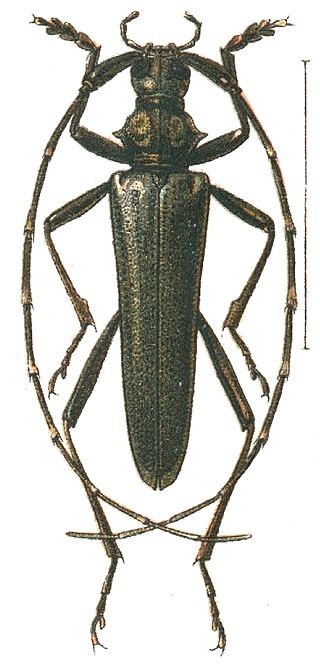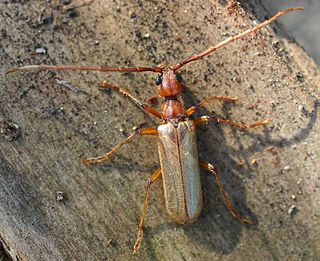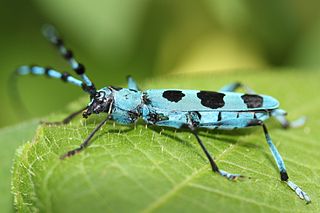
Lamiinae, commonly called flat-faced longhorns, are a subfamily of the longhorn beetle family (Cerambycidae). The subfamily includes over 750 genera, rivaled in diversity within the family only by the subfamily Cerambycinae.

The Disteniidae are a small family of beetles in the superfamily Chrysomeloidea, traditionally treated as a group within the Cerambycidae.

The Vesperidae are a small family of beetles, normally classified within the family Cerambycidae, of heterogeneous aspect but all characterised by larval stages related to roots of herbaceous plants or trees

Cerambycinae is a subfamily of the longhorn beetle family (Cerambycidae). The subfamily has a world-wide distribution including: Asia, Europe and the Americas. Within the family, the only subfamily of comparable diversity is the Lamiinae.

Cerambycini is a tribe of longhorn beetles classified under the subfamily Cerambycinae.

Achrysonini is a tribe of Long-Horned Beetles in the beetle family Cerambycidae. There are more than 20 genera and 50 described species in Achrysonini. They are found mainly in the Americas, but also in Europe, Asia, and Africa.

Clytini is a tribe of beetles in the subfamily Cerambycinae, containing the following genera:

Compsocerini is a tribe of beetles in the subfamily Cerambycinae, containing the following genera:

Eburiini is a tribe of beetles in the subfamily Cerambycinae, synonymous with the tribe Heteropsini Lacordaire, 1868, containing the following genera:
Heteropsini is a tribe of beetles in the subfamily Cerambycinae, synonymous with the tribe Eburiini Blanchard, 1845, containing the following genera:
Compsibidion is a genus of beetles in the family Cerambycidae, containing the following species:
Tropidion is a genus of beetles in the family Cerambycidae, containing the following species:
Gorybia is a genus of beetles in the family Cerambycidae, containing the species:

Aegomorphus is a large genus of beetles in the family Cerambycidae.
Quiacaua vespertina is a species of beetle in the family Cerambycidae. It was described by Monné and Martins in 1973.
Quiacaua abacta is a species of beetle in the family Cerambycidae. It was described by Martins in 1981.
Quiacaua taguaiba is a species of beetle in the family Cerambycidae. It was described by Martins in 1997.
Calliini is a tribe of longhorn beetles of the subfamily Lamiinae.

Desmiphorini is a tribe of longhorn beetles of the subfamily Lamiinae.

Adetus is a genus of beetles in the family Cerambycidae.










